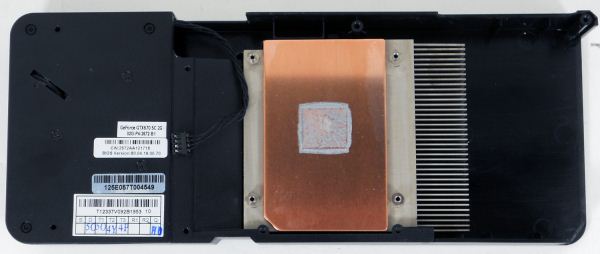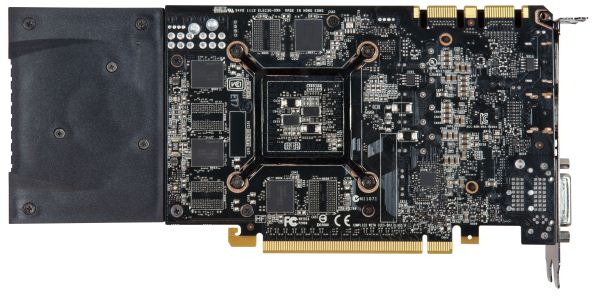NVIDIA GeForce GTX 670 Review Feat. EVGA: Bringing GK104 Down To $400
by Ryan Smith on May 10, 2012 9:00 AM ESTMeet The GeForce GTX 670
Because of the relatively low power consumption of GK104 relative to past high-end NVIDIA GPUs, NVIDIA has developed a penchant for small cards. While the GTX 680 was a rather standard 10” long, NVIDIA also managed to cram the GTX 690 into the same amount of space. Meanwhile the GTX 670 takes this to a whole new level.
We’ll start at the back as this is really where NVIDIA’s fascination with small size makes itself apparent. The complete card is 9.5” long, however the actual PCB is far shorter at only 6.75” long, 3.25” shorter than the GTX 680’s PCB. In fact it would be fair to say that rather than strapping a cooler onto a card, NVIDIA strapped a card onto a cooler. NVIDIA has certainly done short PCBs before – such as with one of the latest GTX 560 Ti designs – but never on a GTX x70 part before. But given the similarities between GK104 and GF114, this isn’t wholly surprising, if not to be expected.
In any case this odd pairing of a small PCB with a large cooler is no accident. With a TDP of only 170W NVIDIA doesn’t necessarily need a huge PCB, but because they wanted a blower for a cooler they needed a large cooler. The positioning of the GPU and various electronic components meant that the only place to put a blower fan was off of the PCB entirely, as the GK104 GPU is already fairly close to the rear of the card. Meanwhile the choice of a blower seems largely driven by the fact that this is an x70 card – NVIDIA did an excellent job with the GTX 560 Ti’s open air cooler, which was designed for the same 170W TDP, so the choice is effectively arbitrary from a technical standpoint (there’s no reason to believe $400 customers are any less likely to have a well-ventilated case than $250 buyers). Accordingly, it will be NVIDIA’s partners that will be stepping in with open air coolers of their own designs.
Starting as always at the top, as we previously mentioned the reference GTX 670 is outfitted with a 9.5” long fully shrouded blower. NVIDIA tells us that the GTX 670 uses the same fan as the GTX 680, and while they’re nearly identical in design, based on our noise tests they’re likely not identical. On that note unlike the GTX 680 the fan is no longer placed high to line up with the exhaust vent, so the GTX 670 is a bit more symmetrical in design than the GTX 680 was.

Note: We dissaembled the virtually identical EVGA card here instead
Lifting the cooler we can see that NVIDIA has gone with a fairly simple design here. The fan vents into a block-style aluminum heatsink with a copper baseplate, providing cooling for the GPU. Elsewhere we’ll see a moderately sized aluminum heatsink clamped down on top of the VRMs towards the front of the card. There is no cooling provided for the GDDR5 RAM.

Note: We dissaembled the virtually identical EVGA card here instead
As for the PCB, as we mentioned previously due to the lower TDP of the GTX 670 NVIDIA has been able to save some space. The VRM circuitry has been moved to the front of the card, leaving the GPU and the RAM towards the rear and allowing NVIDIA to simply omit a fair bit of PCB space. Of course with such small VRM circuitry the reference GTX 670 isn’t built for heavy overclocking – like the other GTX 600 cards NVIDIA isn’t even allowing overvolting on reference GTX 670 PCBs – so it will be up to partners with custom PCBs to enable that kind of functionality. Curiously only 4 of the 8 Hynix R0C GDDR5 RAM chips are on the front side of the PCB; the other 4 are on the rear. We typically only see rear-mounted RAM in cards with 16/24 chips, as 8/12 will easily fit on the same side.
Elsewhere at the top of the card we’ll find the PCIe power sockets and SLI connectors. Since NVIDIA isn’t scrambling to save space like they were with the GTX 680, the GTX 670’s PCIe power sockets are laid out in a traditional side-by-side manner. As for the SLI connectors, since this is a high-end GeForce card NVIDIA provides 2 connectors, allowing for the card to be used in 3-way SLI.
Finally at the front of the card NVIDIA is using the same I/O port configuration and bracket that we first saw with the GTX 680. This means 1 DL-DVI-D port, 1 DL-DVI-I port, 1 full size HDMI 1.4 port, and 1 full size DisplayPort 1.2. This also means the GTX 670 follows the same rules as the GTX 680 when it comes to being able to idle with multiple monitors.
















414 Comments
View All Comments
Pantsu - Saturday, May 12, 2012 - link
So you completely ignored the truth about the price difference, and could not even understand the review.You can continue believing that Nvidia drivers are perfect and if there's a problem, it's obviously not Nvidia's. Meanwhile I keep on playing Shogun II. :)
CeriseCogburn - Saturday, May 12, 2012 - link
Yes, whatever, the 7970 has fallen to where it belongs, $100 less than the 680 - I haven't ignored that, I said go buy your fallen junk, but just don't spew out your lies about OC superior not ready to back it up.Go get the loser card, no problem- just stop telling me it's better when it crashed to dingbat bin price as soon as the 680 stood up. There is a reason for that, one you refuse to acknowledge. You people obviously believe the laws of the market do not apply, and often stretch scientific reality to the outer realms as well.
Let us know if you have half your games fail if you ever do buy a card, which it appears by all the talk and no action yet, you are not going to anyway, so it's been fun watching the endless spinning from you nonetheless.
raghu78 - Thursday, May 10, 2012 - link
RyanIncluding a 670 OC in your benchmarks while not including HD 7950 OC when you have so many HD 7950 OC cards available in the market is not an objective and fair comparison. Given that HD 7950 OC editions are available at USD 399 those should have been included. HD 7950 scales beautifully with higher clock speeds. In your overclocking section there should be HD 7950 OC edition benchmarked at overclocks using AMD CCC. HD 7950 OC cards regularly hit 1050 Mhz in AMD CCC. I am confident the HD 7950 OC at 1050 Mhz will give the GTX 670 OC overclocked a run for its money.
The fact that HD 7970s have been available from launch day at 1 Ghz speeds like XFX HD 7970 DD Black edition and that recently cards like MSI HD 7970 Lightning (1070 Mhz) and Powercolor PCS+ HD 7970 Vortex II (1100 Mhz) too have been available should be considered. The least you can do is include the 7970 OC cards and 680 OC cards to give a clear idea of the potential of these GPUs.After 4 months from HD 7970 launch I am yet to see a single HD 7970 OC edition review other than the XFX HD 7970 DD Black edition which was done on Jan 9, 2012.
I can't speak for anyone but frankly it seems that there is bias towards Nvidia. In my opinion the HD 7970 and HD 7950 are good products and superior than GTX 680 / GTX 670 given its focus on gaming and compute. Also the Tahiti chip performance scales beautifully with OC and it has great OC headroom. I expected anandtech to do a better job at making a really fair and objective comparison.
Ryan Smith - Thursday, May 10, 2012 - link
Hi raghu;As a matter of policy we only include the OC results for the card(s) being reviewed in the article. The purpose of our OC testing is not to determine what overclocked card is faster, but rather to give you an idea of how far we could overclock the card being reviewed and what kind of performance it can achieve.
We do not review overclocked cards in the manner you suggest because that's one lucky/unlucky card away from having significantly different results (just look at our memory overclocks). GPU overclocking is unreliable and should be considered a nice extra at best; it should not be used as the basis to choose between different GPUs.
-Thanks
Ryan Smith
raghu78 - Thursday, May 10, 2012 - link
The least anandtech can do is have separate HD 7950 OC vs GTX 670 OC cards and 680 OC vs HD 7970 OC cards head to head comparison reviews.The fastest OC models in the market for both cards can be choosen and benched both at stock and overclocked. Such reviews would give a clear idea of the potential of the GPUs.
RussianSensation - Thursday, May 10, 2012 - link
Look at the benchmarks where GTX670 OC wins. The lead is so dramatic, even if you overclock HD7950 by 40-50%, it still won't win. And that's assuming perfect 40% scaling with a 40% overclock which won't happen on the 7950.Of course hardly anyone would buy a card for the same price that requires overclocking lottery of 50% just to match a reference overclocked 670, not to mention the 7950 would consume 100W+ more power in the process. 7950 is no longer relevant at $399. It needs to drop to $349 at most. Also, some $420-430 after market 670s already hit 1300-1400mhz in GPU Boost which would easily go head to head with a 1250mhz 7970. HD7950 has no chance.
raghu78 - Thursday, May 10, 2012 - link
I look at the most demanding games at maximum image quality settings which are doing less than 60+ fps at 2560 x 1600 cause those are the games that really stress the GPU . BF3 , Alan Wake, Crysis 2, The Witcher 2, Total War Shogun 2, Anno 2070, Batman Arkham City fall in that list. Above 60 fps its not going to make a difference unless you are in a multiplayer competition. A HD 7970 at 1250 Mhz will beat or tie a 680 OC at 1350 Mhz in each of these games. Wanna betMorg. - Thursday, May 10, 2012 - link
I'll bet on that lightning ;) - but tbqh IT would help to see a benchmark of more recent tahiti dies, yields have far improved since release after all.JlHADJOE - Thursday, May 10, 2012 - link
HH benchies say they're just about even at 5760x1080 (6.2Mp), even when the AMD card has the higher clocks. Nvidia won every test at the lower resolution of 1080p (2.1Mp). It's a bit hard to infer performance at 1600p (4Mp) but I'm guessing they should be nearly even.MSI Lightning 7970 @ 1265
ASUS Reference 680 @ 1218 Boost
http://www.hardwareheaven.com/reviews/1455/pg6/asu...
CeriseCogburn - Friday, May 11, 2012 - link
Yes, how much are we betting, how about thousands.http://hexus.net/tech/reviews/graphics/37209-gefor...
PAY UP.